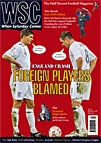 For the second time this year, Italian football has been rocked by a violent death, but this time the killer was a policeman and the victim was a fan asleep in a car. Vanda Wilcox examines the tragedy
For the second time this year, Italian football has been rocked by a violent death, but this time the killer was a policeman and the victim was a fan asleep in a car. Vanda Wilcox examines the tragedy
In the early hours of Sunday November 11, Gabriele Sandri climbed into the back of a friend’s car and went straight to sleep. A group of fans were headed for Milan, to watch Lazio take on Inter. The 28‑year-old shop manager had been up DJ‑ing all night at one of Rome’s best-known night clubs, but his nightlife never stopped him from following Lazio home and away, however far he had to travel. He was friends not only with individuals in the club’s established ultra groups – though not himself a member – but also some players.
Stopping for coffee at a service station in Tuscany, the group encountered some Juventus fans travelling to Parma. Insults were exchanged, then threats, then fisticuffs, probably instigated by the group of Lazio fans. Sandri, meanwhile, was still asleep in the back of the car; the Laziali rejoined him and set off. As the driver turned on to the motorway he caught a glimpse of a man standing on a raised mound, arms outstretched before him, a pistol in his hands. Seconds later, two shots were heard. Only as the car pulled away did the group realise that Sandri had been shot in the neck through the rear window: he died before they reached the next emergency exit. Luigi Spaccarotella, the highway patrol officer who opened fire, initially claimed to have fired a “warning shot in the air”, but ballistics evidence and eyewitness accounts have disproved this. At present, he is to be charged with non-premeditated murder.
Confused and contradictory reports of Sandri’s death spread rapidly. Ultras across Italy initially heard only that the police had killed an ultra at a service station. The widespread expectation was that the day’s games would be cancelled, just as had happened in February when a police inspector, Filippo Raciti, was killed during rioting in Catania. Instead the chief of police, Antonio Manganelli, rejecting this precedent and hoping to avoid this very comparison, ordered that all games be played with just a ten-minute delay as a mark of respect. Only Inter v Lazio was postponed, at the request of the Lazio players.
The consequences were dire, with violence directed against the police breaking out across the country. Ultras – like many other groups in Italian society – are notorious for their hatred of the police even at the best of times. In Milan, ultras of several teams united to march through the city bearing a banner proclaiming: “For Raciti you stopped the league, but the death of a fan doesn’t matter.” The worst violence was in the capital, where furious Lazio hooligans were joined by their Roma counterparts in a co‑ordinated riot that lasted for hours. Despite a belated decision to call off Roma’s home game, a mob of up to a thousand people besieged police stations before attacking the headquarters of CONI, the governing body for all sports in Italy. An incendiary device was thrown into the building, windows were smashed, vehicles and dustbins were overturned and set on fire. The area around the Stadio Olimpico resembled a war zone: streets littered with rubble and broken glass, wrenched-up road signs and assorted impromptu weaponry.
Following the universal condemnation of this unprecedented outbreak of hooliganism, some encouraging action has been taken by the authorities. Multiple arrests have followed in Milan, Bergamo and Rome, where two men have been charged with incitement to violence against the state under new anti-terror legislation. As so often, there may be a political element. There are indications that the Rome riots may have been organised or directed by members of neo-fascist party Forza Nuova – who were also implicated in February’s rioting in Catania. Of course, Italy’s violent curve are by no means the exclusive province of the extreme right: Atalanta’s ultras, who committed some of the day’s worst violence, have traditionally come from the left.
Though there has not been the blanket ban on away travel some feared, more stringent restrictions have been announced, which include the application of new individual banning orders and the more rigorous enforcement of those already in place. A fans’ ID card system has been mooted to increase supervision of ticket sales. Meanwhile the Atalanta curva will be closed until March, and the club’s president has vowed to eradicate the violent element there.
These events have once again raised the question: is “ultra” just a fancy word for hooligan? Clearly, many ultras are just that. But the issue is more complex, as demonstrated at Sandri’s funeral, where hundreds of ultras arrived to pay their respects to “one of their own”. Groups and individuals represented not only Lazio and Roma but also Juventus, Taranto, Avellino, Genoa and Livorno. Floral wreaths in club colours from Napoli, Sampdoria, Torino and Milan groups lay alongside scarves from Udinese, Palermo and Messina. These ultras had travelled from all over Italy simply to stand outside a church in the pouring rain, in a silent farewell to a man they had never known. This peaceful manifestation of solidarity issued a timely reminder that the ultra mentality is not intrinsically violent. The crowd called repeatedly for “Justice for Gabriele”. But beyond justice, the best tribute to his memory would be an eradication of the violence that blackens the name of Italian football and of those who claim to love it the most.
From WSC 251 January 2008